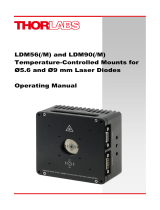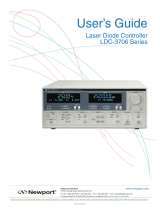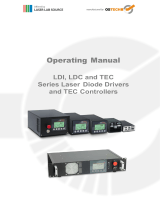
Temperature-Controlled Laser Diode Mount Chapter 7: Troubleshooting
Page 16 TTN121167-D02
Chapter 7 Troubleshooting
Problem Solution
Laser Driver will not
enable.
(If you are using
Thorlabs Laser and TEC
controllers with your
LDM56F(/M) mount.)
Remote Interlock is open.
Make sure that either the “shorting device” is installed in
the INTERLOCK connector on the side of the
LDM56F(/M), or if you have a remote interlock switch
connected, it must be in a closed position.
TEC LOCKOUT circuit is active and the TED series TEC
controller is not enabled.
To determine if you have selected the TEC LOCKOUT
circuit to be active refer to section 5.2. If it is selected,
then the TED series TEC controller must first be enabled
before the LDC series laser controller can be enabled.
Laser wavelength or
power is unstable even
though the TEC
controller shows a stable
temperature.
Make sure your laser diode is fully inserted into the
LDM56F(/M) laser socket and its body is in full contact
with the copper cold plate.
Make sure the mounting flange is correctly installed over
your laser.
The LDC series laser
driver indicates an “Open
Circuit” alarm when the
laser is enabled.
The LD and PD polarity switch settings are incorrect.
Refer to Figure 2 and the data sheet for your specific
laser diode to ensure the proper settings. The LD polarity
switch setting on your LDM56F(/M) must also match the
LD polarity switch setting on the rear panel of your LDC
series laser diode controller.
The laser diode is installed into the wrong pins on the
laser diode socket. Refer to Figure 3 for the correct
orientation of the laser diode pins and compare this to
the data sheet for your laser diode.
The LD does not have an
integrated photodiode,
how does it get installed
and how do the polarity
switches get set?
If your laser diode has one of its two active leads
common to the case of the laser, that lead must be
connected to one of the “GND” sockets on the laser
diode connector (refer to Figure 3) while the other pin is
connected to the “LD” socket in the 9 o’clock position.
Depending on the pin orientation of your laser, you might
be using either the “GND” socket at 12 o’clock or the
“GND” socket at 3 o’clock. Refer to your laser diode data
for pin orientation. If your Cathode pin is common to the
body of your laser diode, set the LD polarity switch to
“CG”. If your Anode pin is common to the body of your
laser diode, set the LD polarity switch to “AG”. The
setting for the PD polarity switch is irrelevant.
If you still have problems or questions regarding the operation of your LDM56F(/M)
please feel free to contact your local Tech Support office.

































